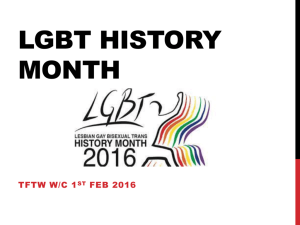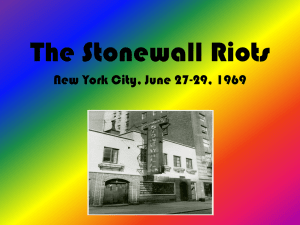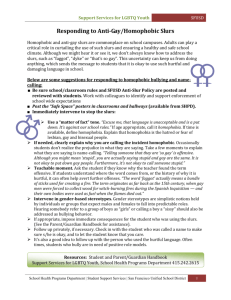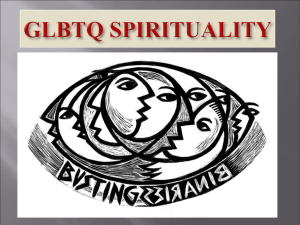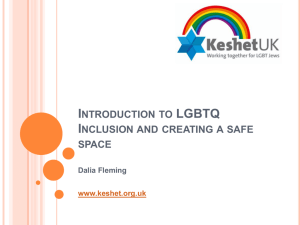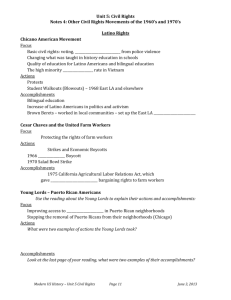Techniques to train others in primary schools
advertisement
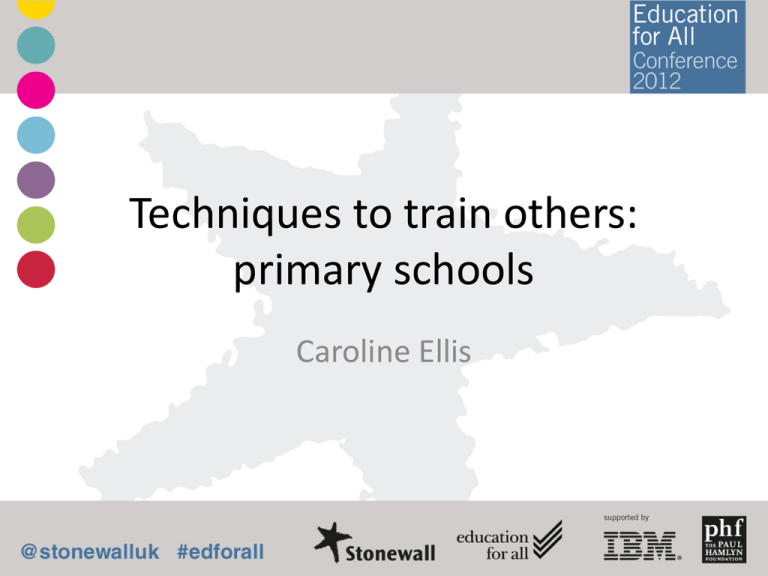
Techniques to train others: primary schools Caroline Ellis • Variety of exercises for you to use, adapt, reject • Examples of ways to use the existing resources • Top 10 tips for training others 9 out of 10 teachers say they have never received any specific training on how to prevent and respond to homophobic bullying But: 71% of primary school teachers say they feel some confidence addressing gay issues in the classroom Confidence ruler NOT AT ALL VERY How confident do you feel challenging homophobic language in the classroom? Confidence ruler NOT AT ALL Example questions: Why are you at 3 and not zero? What would it take for you to move to 5? VERY The Wall What are the barriers that prevent you from challenging homophobic language in the classroom? The Wall Example questions: How might you remove these barriers in the immediate situation? How else might you remove these barriers ? Facilitated discussion • Pick an example from one of the training resources • Use it to facilitate a discussion • Can be an extended interaction – e.g. show a clip, discuss and then show more • Have prompt questions ready: – What do you think about what the children and teachers say in the clip? – What should we do in our school? – What could we do in our school? • Have other relevant resources at hand to refer to – Including different families guide – Celebrating Difference, Challenging homophobia in primary schools DVD Facilitated discussion - example (clip of ‘Language’ section of Stonewall ‘Celebrating Difference’ DVD. For more information contact Stonewall: education@stonewall.org.uk) • What do you think about what the children and teachers say in the clip? • What should we do in our school? • What could we do in our school? Ways to practice – Case studies • Pick examples from the resources that are relevant to you • Use the 3 aims of the public sector equality duty as a framework to focus the questions. In this situation: – How could you eliminate discrimination, harassment and victimisation in this situation? – How could you advance equality of opportunity? – How could you foster good relations between different groups? Case study example Jordan has come to see you after class. He tells you he’s upset because he keeps hearing friends and other people using the word ‘gay’ all the time, to mean something bad. He’s tried telling them to stop but they just laugh and start calling him gay. He tells you that he has two Mums, that what people are saying at school is about gay people and it really bothers him. Jordan says that a few weeks ago he asked another teacher what he should do, but she told him that people were not saying anything about his Mums personally and that he should just ignore it. In this situation: • How could you eliminate discrimination, harassment and victimisation? • How could you advance equality of opportunity? • How could you foster good relations between different groups? Ways to practice – role plays • Pick examples from the resources that are relevant to you • Assess levels of confidence • Can be delivered in different ways: – Individual – pairs/ trios/ small groups – Interactive – facilitators or participants: “stop the action” or “good practice/ bad practice” • Give clear instructions • As with case studies, you can use the 3 aims of the public sector equality duty as a framework to focus the discussion Top 10 tips for training others 1. Use the group – alongside you, they are the experts 2. Use selected statistics that will engage your audience 3. Frame the training positively 4. Use the legislation as a framework and a tool, not as a weapon 5. Use the resources to inform sessions, not as complete sessions Top 10 tips for training others 6. Make it manageable – one well delivered exercise may be most effective 7. Consider the flow of the session – don’t start with role play 8. Use exercises like the wall to inform future sessions such as case studies or role plays 9. Involve others in the planning, and possibly delivery 10. Encourage others to champion change by building in individual action planning




